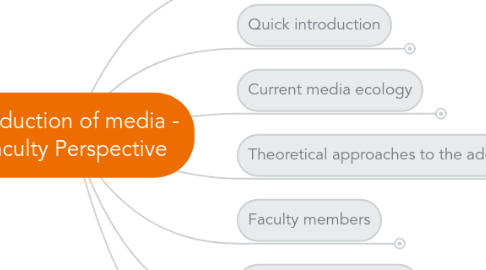
1. A presentation from the faculty perspective on what type of support faculty need when starting a media project and how they can best be supported in the process.
1.1. You can access this mind map at http://goo.gl/Tp3i4F
2. Quick introduction
2.1. Professor of Communication Studies at Sacramento State
2.2. Member of the CA OER Council
2.2.1. http://icas-ca.org/coerc
2.3. Developer of curricular materials for ICT Literacy Initiatives, CSU
2.3.1. http://teachingcommons.cdl.edu/ictliteracy/about/
2.4. Participated in Sacramento State's Teaching Institute for more than a decade
2.5. Developer of hypermedia
2.5.1. http://diego.today
3. Current media ecology
3.1. Speed of change is very fast
3.2. Different ability to keep up with changes
3.2.1. Faculty already in the workforce
3.2.2. Faculty who grew up with computers
3.3. Faculty members ICT literacy
3.3.1. Information literacy
3.3.1.1. Awareness of what is out there and how to get it
3.3.2. Digital media literacy
3.3.2.1. How can I "speak" with the new medium?
3.3.2.2. Producing digital media
3.3.3. Computer literacy
3.3.3.1. Understanding of how a computer operates
3.4. Media ecology with faculty members with very different levels of ICT literacy
4. Theoretical approaches to the adoption of mass media
4.1. Marshall McLuhan
4.1.1. The content of the medium is previous media
4.2. Paul Saffo
4.2.1. The production of content that utilizes the characteristics of the new medium takes 30 years
4.3. Lev Manovich
4.3.1. The principles of new media
5. Faculty members
5.1. Generalizing, as creatures mostly of the print medium, faculty members are accostumed to individual efforts
5.2. From a media-based perspective, their processes are dominated by the logic of print media
5.2.1. Print
5.2.1.1. Individualistic efforts
5.2.2. Other media
5.2.2.1. Collaborative efforts
5.3. Individual efforts translate into control over work schedules
6. What type of support?
6.1. Envision the final product
6.1.1. Examples of previous projects supported by the institution
6.1.2. Faculty members are quite good at following models
6.1.3. If possible, describe faculty members needs by referencing other projects
6.2. Awareness of what is possible, what is needed, and its potential impact
6.2.1. Expectations
6.2.1.1. Collect faculty member's previous work
6.2.1.1.1. It is very telling
6.2.1.2. Evaluate, as best as you can, the faculty member's ICT literacy
6.2.1.3. Making expectations realistic (while maintaining enthusiasm)
6.2.2. Content
6.2.2.1. Reinventing the wheel?
6.2.2.1.1. Early adoption of OERs (Diffusion of innovations)
6.2.3. Impact
6.2.3.1. Obscure course
6.2.3.1.1. Unique
6.2.3.1.2. Probably nothing much out there
6.2.3.2. GE course
6.2.3.2.1. Common
6.2.3.2.2. Resources available
6.2.3.3. Market $
6.2.3.3.1. Difficult in the current ecossystem
6.2.3.3.2. The adoption of OERs speaks to this
6.3. Production management
6.3.1. Design
6.3.1.1. Visual organization matters
6.3.1.1.1. Mind maps are quite helpful to present information schematically
6.3.1.2. Construct products as a collection of individual modules
6.3.1.2.1. Complete enough modules (1?) as to have a thorough understanding of
6.3.1.2.2. Budget based on the initial module (resources and time)
6.3.2. Production management
6.3.2.1. On call at the beginning
6.3.2.2. Schedule based on the faculty members academic semester
6.3.2.2.1. Last weeks of classes are very busy
6.3.2.3. If faculty member is comfortable, create shared production resources
6.3.2.3.1. Think Web 2.0
6.3.2.4. Automated reminders
6.3.2.4.1. They do their job while reducing friction
6.4. Varying support
6.4.1. Faculty member's contributions
6.4.2. Institutional contributions
6.4.3. Finding the right balance helps the overall process
6.4.4. Shift the balance through time
7. Questions
7.1. Is there a need to "level" what the faculty member envisions with what the media unit can produce?
7.1.1. Agreement
7.1.2. Right expectations
